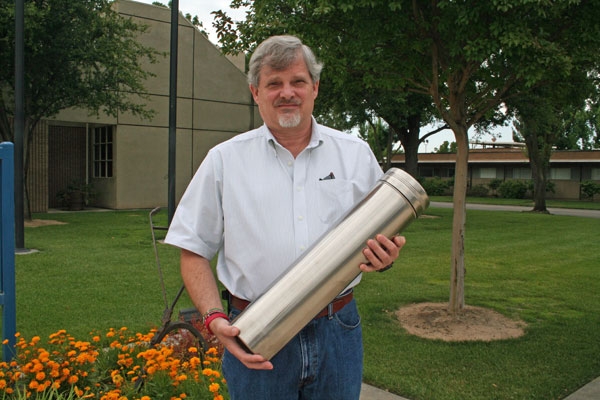
Center director Jeff Dahlberg, who will be 108 years old in 2065, predicted in his letter that today's modern technology – smart phones and computers – will be ditched by then in favor of holographic demonstrations about new plants and agronomic practices.
“You'll be able to see, in 3-D, how plant systems function, how genes work, and what happens when you turn a gene off or on and the cascading effects of those actions,” Dahlberg predicted.
A time capsule containing the letters will be buried on May 26, exactly 50 years after the May 26, 1965, dedication of the sprawling research station near Parlier in the Central San Joaquin Valley. It will also contain a 20-foot-long banner with a timeline showing significant research accomplishments at Kearney. The banner will have signatures and messages from all the attendees at the 50th anniversary celebration on May 26, 2015.
Kearney is one of nine agricultural research and extension facilities UC Agriculture and Natural Resources maintains in California. The northernmost is on the Oregon border near Tulelake; the southernmost is in Holtville, a short drive from the border with Mexico. Centers are found in the Sierra foothills, in the North Coast and in suburban Southern California. Each center represents local conditions and focuses on crops and activities important in the area.
At the 330-acre UC Kearney Agricultural Research and Extension Center, scientists conduct research on a diversity of Central San Joaquin Valley crops, including grapes, stone fruit, almonds, pistachios, pomegranates, kiwi fruit, blueberries, alfalfa and more recently sorghum. Twenty Ph.D.-level scientists are based at the center, where they conduct research in pest control, new crop varieties, plant disease control and irrigation strategies.
A scientist who joined the staff in 2013, Kris Tollerup, UC ANR Cooperative Extension advisor with the UC Statewide Integrated Pest Management Program (IPM), will be looking for some answers from his successors.
“Growers and pest control advisors are reluctant to adopt new IPM practices until they are well proven,” Tollerup wrote. “I am curious, do you face the same challenge?”
Since Tollerup will be 105 when the time capsule is opened, his young children, who will be 54 and 58 in 2065, may have to collect the responses for him.
UC IPM advisor Pete Goodell, who with 34 years of service to UC ANR is approaching retirement, had sage advice for successors that might continue to be bombarded with modern conveniences.
“My advice,” Goodell wrote. “Get out of the office and get to the farm . . . Create and nourish human networks as well as virtual ones.”
Goodell tells his successors that, no matter the technological advances that are sure to come, knowledge transfer will always be based on personal contact and trust.
“Humans, even in your time, are high touch species who thrive on social interaction,” he said.
The other three letters going in the time capsule include these quotes:
“I assume that (nematodes) still will be around when you read this letter. At least this is something that I tell my students: ‘nematode problems will outlive us.'” – Andreas Westphal, UC ANR Cooperative Extension nematology specialist.
“Release of genetically modified mosquitoes carrying sex lethal genes has been approved on a relatively small scale in a few countries. I wonder if this method of control will be better perceived in the future and become the norm?” – Anthony Cornel, entomologist and director of the Mosquito Lab at Kearney.
“It will be interesting to see how the citrus industry adapts to the (Asian citrus psyllid/huanglongbing) situation. Growers are very creative people and I believe they will find a way.” – Beth Grafton-Cardwell, UC ANR Cooperative Extension entomology specialist.
Author: Jeannette Warnert